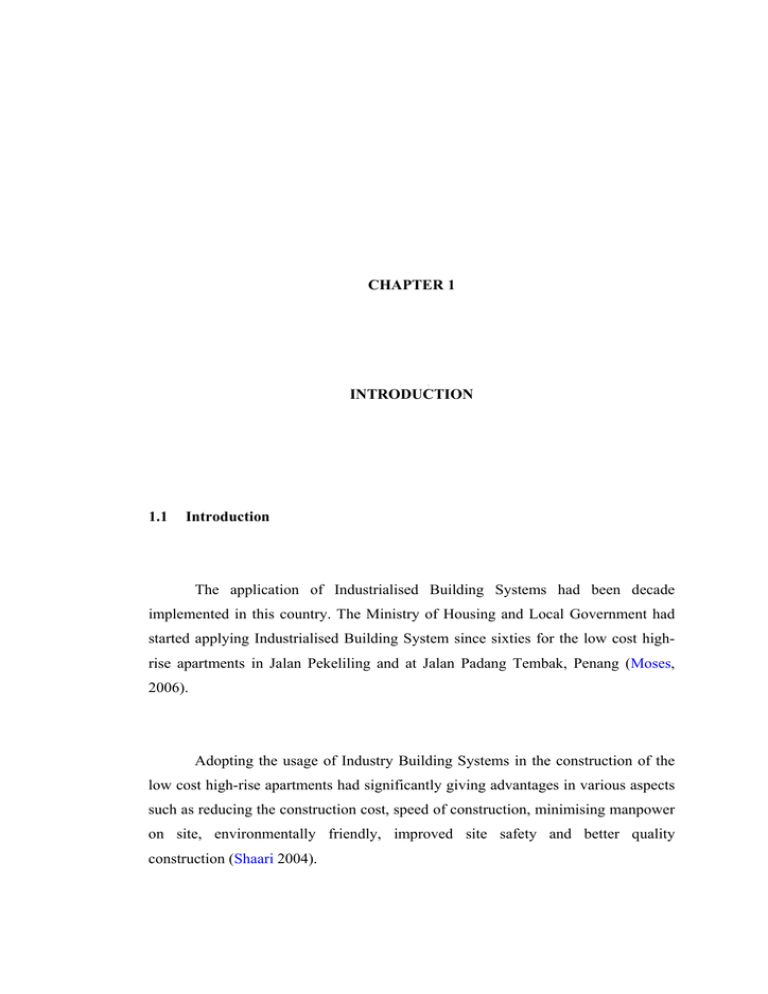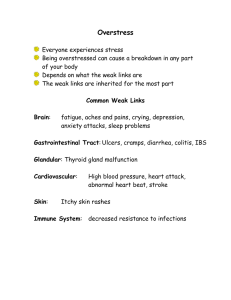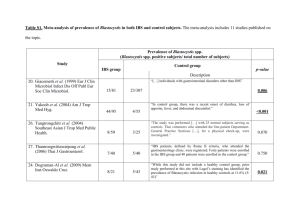CHAPTER 1 INTRODUCTION 1.1 Introduction
advertisement

CHAPTER 1 1 K INTRODUCTION 1.1 Introduction The application of Industrialised Building Systems had been decade implemented in this country. The Ministry of Housing and Local Government had started applying Industrialised Building System since sixties for the low cost highrise apartments in Jalan Pekeliling and at Jalan Padang Tembak, Penang (Moses, 2006). Adopting the usage of Industry Building Systems in the construction of the low cost high-rise apartments had significantly giving advantages in various aspects such as reducing the construction cost, speed of construction, minimising manpower on site, environmentally friendly, improved site safety and better quality construction (Shaari 2004). 2 1.2 Background of the Research Malaysia’s housing policy is gearing toward meeting the objective of ensuring access to adequate and decent shelter to all citizens, particularly the lowincome groups. The national housing policy will effectively contribute to the provision of physical shelter as a basic social need toward improving and enhancing the quality of life through the erection of decent and viable human settlements. In implementing this policy, the quantitative and qualitative aspects of housing development are taking into account. Table 1.1 shows the targets and achievements of the various Malaysia's 5year Plans. By and large, the performance of the public and private sectors in delivery of houses was below the estimated targets except for the 3rd, 6th and 7th Malaysia Plans where the private sector performed excellently, surpassing the targets set. During the Third Malaysian Plan period, there was rapid economic and social development, leading to a great expansion of private sector, but most of the houses constructed were medium and high costs. After the rapid expansion experienced during the Third Malaysian Plan, the economy took a downturn where the performance of the private and public sector during the Fourth and Fifth Malaysian Plan was poor. The public sector delivered 190,045 units of houses out of a target of 398,570 units, while the private sector delivered 201,933 units out of a target of 524,730 units. During the Fifth Malaysian Plan, the public sector built only 97,126 units of houses out of a target of 149,000 units planned while the private sector delivered 203,802 units out of a target of 552,550 units planned. 3 During the Seventh Malaysian Plan, targets of 800,000 units of houses planned for construction and the end of 2000; however, both the private and public sectors constructed 859,480 units of houses, giving it an achievement rate of 107.4% of the target. The housing industry experienced remarkable growth in the 1990's but badly affected by the economic crisis beginning July 1997. Under the Eighth Malaysian Plan (2001–2005), refer to Table 1-2 the overall performance of houses built under the low-cost housing category was encouraging with 200,513 units completed or 86.4 per cent of the Plan target. Of this total, 103,219 units or 51.5 per cent constructed by the public sector (Ministry of Finance, Ninth Malaysian Plan). Table 1.1 Public and private sector housing programmes target and performance of the period 1971-2000 Second M 'sia Plan(1971-1975) A gency T arg eted P U B LIC SE C TO R : Third M 'sia Plan(1976-1980) Fourth M 'sia Plan(1981-1985) Fifth M 'sia Plan(19861990) Sixth M 'sia Plan(1991-1995) Seventh M 'sia Plan(1996-2000) C o m pleted T arg eted C om pleted T argeted C om pleted T argeted C om pleted T arg eted C om p leted T argeted C om pleted 1. P ublic low -cost housing - 13,244 62,200 26,250 176,500 72,302 45,800 26,172 40,000 15,376 64,000 62,812 2. H ousing in land schem es - 41,965 60,000 36,770 110,010 36,112 57,500 32,056 56,100 8,075 9,300 7,188 - 24,240 41,300 20,560 58,500 23,258 27,000 11,284 32,600 18,776 102,700 12,015 - 6,627 57,300 37,930 53,560 58,373 18,700 27,614 45,300 42,315 54,000 39,609 86,076 220,800 121,510 398,570 190,045 149,000 97,126 174,000 84,542 230,000 121,624 64,862 100,00 199,490 - - - - - - - - Low -cost housing - - - 90,000 22,794 370,400 88,877 215,700 212,003 137,000 127,514 M edium and high-cost housing - - - 259,470 79,005 169,600 107,442 170,700 339,610 418,000 596,639 12,000 4,120 25,260 5,474 12,500 7,483 12,600 11,305 15,000 13,703 3. Institutional Q uarters and other staff A ccom m odation 4. S E D C 'S P rojects and other state projects / m edium and high-cost housing S ub-total P R IV A TE S E C TO R : 1. P rivate D evelopers - 2. C o-operative S ocieties - 3. Individuals and G roups - 108,872 150,000 159,070 150,000 94,660 - - - - - - Sub-total - 173,734 162,000 362,680 524,730 201,933 552,500 203,802 399,000 562,918 570,000 737,856 TO TA L - 259,810 382,800 484,190 923,300 391,978 701,500 300,928 573,000 647,460 800,000 859,480 Source: Research and Development Division, National Housing Department, Malaysia, April 2001 Table 1.2 Public and private sector housing targets and achievements, 2001-2005 Housing for the Poor Programme Public Sector Target Achieve units units 16,000 10,016 Low-Cost Low Medium-Cost Medium % of Target Achieve % of Target units units Target 192,000 103,219 62.6% 53.8% Target Achieve units units 37,300 22,826 Medium-Cost High-Cost Total % of Target Achieve % of Target Achieve % of Target Achieve % of Target units units Target units units Target units units Target 46,700 30,098 20,000 22,510 112.6% 312,000 61.2% 64.4% 188,669 60.5% 81,108 46.3% Low-cost Housing 175,000 81,108 46.3% 175,000 - Housing for the hardcore poor 15,000 9,536 63.6% 15,000 9,536 63.6% 48.0% 1,000 480 48.0% 56,000 47,505 84.8% 3,000 6,420 214.0% 1 Sites and Services 1,000 480 Housing by Commerical Agencies Housing by Land Schemes 15,000 16,386 109.2% 10,000 15,442 154.4% 2,000 5,725 286.3% 1,000 695 69.5% 16,000 9,924 62.0% 15,000 5,753 38.4% Institutional Quarters - Institutional Quarters and Staff Accomodation 26,300 6,689 25.4% 30,700 20,174 65.7% 5,000 16,757 335.1% 62,000 43,620 70.4% Private Sector 40,000 97,294 243.2% 94,000 61,084 65.0% 64,000 222,023 346.9% 105,000 274,973 261.9% 303,000 655,374 216.3% Private Developers 39,000 94,029 241.1% 90,000 53,607 59.6% 60,000 215,267 358.8% 100,000 269,320 269.3% 289,000 632,223 218.8% 1,000 3,265 326.5% 4,000 7,477 186.9% 4,000 6,756 168.9% 5,000 5,653 113.1% 14,000 23,151 165.4% 232,000 200,513 86.4% 131,300 83,910 63.9% 110,700 252,121 227.8% 125,000 297,483 238.0% 615,000 844,044 137.2% Cooperative Societies Total 16,000 10,017 62.6% 6 During the Ninth Malaysia Plan, continuous efforts undertaken by the government to ensure that Malaysians of all income levels will have access to adequate, quality and affordable homes, particularly the low-income group. In this regard, the private sector will be encouraged to build more low- and low-mediumcost houses in their mixed-development projects while the public sector will concentrate on building low-cost houses for the poor either urban or rural areas (Ninth Malaysian Plan). While the problem of housing grows more acute, Malaysia is struggling to meet its own housing needs and is doing so through an increasingly advance technology. The conventional construction method, due to the slow pace of construction and higher cost, is not be able to meet the demand Malaysia is presently taking a hard look at IBS as an answer to a housing shortage problem. The main advantages of using IBS, according to a report published by the Malaysian Ministry for Local Government and Housing Ministry, 1997, are speed of construction, quality, and economic advantage, all of which are required to meet such a large demand for housing. It been suggested that there are a number of appropriate IBS, useful for a wide range of specific uses and situations, but none of them is applicable to all construction sites. They are dependent upon and influenced by many other aspects of the housing situation, aspects such as land use, density, volume, environmental conditions, user needs, continuity of demand, and labour (Swee, 1988). The research of this project will investigate the significant usage of the construction procedure of the slab and wall form technique of the IBS for the construction of high-rise low cost apartment. 7 1.3 Justification of the Research Presently, many of the low cost high-rise apartments built with the slab and wall form technique, but none of the construction procedure explored and analysed. The contributions of this research ascertained in terms of benefits gained by both the industry and the individual. 1.4 Problem Statement In the process of nurturing the industry towards less labour dependent, the government of Malaysia through CIDB, had aggressively promoting the development and usage of new and relevant technologies in the area. Using the IBS had seen as the alternatives that can greatly reduce construction time compare to the conventional method (Abraham Warszawski, 1999). It anticipated that by using the IBS, the foreign labour dependency can be hugely reduce where now the foreign labour controlling almost 75% of overall workers in this industry. In line with the problems, the Prime Minister on 10 September 2004, during the 2005 budget speech, stressing that the government supporting the IBS and will ensure the usage of IBS where the essence of the industry is to reduce on foreign labour dependency and minimising of time and cost of the construction. “Speech by Abdullah, 2004 says that the Government intends to provide an additional 100,000 units of affordable homes to be implemented through the Industrialised Building System (IBS). This system will ensure quality construction, save cost, create a safer and cleaner working environment as well as reduce the 8 dependence on foreign workers. The usage of IBS components in Government building projects will increase from 30 percent currently to 50 percent commencing 2005. Housing developers, who utilise IBS components exceeding 50 percent, will be given full exemption on levy imposed by CIDB.” 1.5 Objectives of the Study The main aim of the research is to investigate the significant usage construction procedure of the selected slab and wall form technique of the IBS for the construction of high-rise low cost apartment. The specific objectives were: i. To identify types of IBS for slab and wall form technique for the construction of the high-rise low cost apartment. ii. To identify the benefits of the slab and wall form technique for the construction of high-rise low cost apartment. iii. To evaluate and simulate the cost comparison between the selected IBS of slab and wall form technique for the construction of high rise low cost apartment 9 1.6 Research Scope This research carried out with a careful study on the data collected mainly from questionnaire survey exercise and case studies. The research will focus on the government projects that are using wall form technique of the industrialised building systems (IBS). The study is limited to low cost high-rise apartments constructed in Johor Bahru and Klang Valley. Nine projects sampled for this research. Towards achieving these objectives, overall research made through 1.7 i. National Housing Department ii. CIDB iii. Contractors iv. Consultant v. Developers Literature Review Malaysia's rapid economic development and the transformation process from an upper middle income developing country towards the industrialised and developed nation status as envisaged in Vision 2020 has created the environment for the development of the construction industry. The construction industry has 10 played an important role in establishing the infrastructure required for socioeconomic development and contributing directly to economic growth. The country's processes of integration, industrialisation and urbanization have generated growth and changes in construction output. Whilst, the construction industry plays a vital role in Malaysia's development and expected to be a major contributor towards the realisation of Vision 2020 and this industry is too dependent of the foreign labour in ensuring it to grow. Registered foreign labour in the country has rapidly increasing from approximately only 25,000 in 1990 to 278,102 in 2006 (Statistic Department and Immigration Department, 2006). The phenomenon of the foreign labour dependent were because of the lost of interest among the local to work in this industry because of 3-D problem or 3-K that is Dirty (Kitarai), Difficult (Kitsui) and Dangerous (Kiken). Through the Construction and Industry Board (CIDB) it was found that almost seventy five percent of the foreign workers whom were requesting for the advance test for the permit extension are involved in wet-trade such as carpenter, welder, bar bender, plasterer and brick layer (Shaari. 2004). 1.7.1 Industrialised Building Systems (IBS) Industrialised Building Systems (IBS) defined as building system in which structural components manufactured in a factory, which located on-site or off-site, transported and assembled into a structure using suitable equipments with a minimal additional site works (CIDB, 2003). 11 The usage of IBS is widely used in Malaysia construction industry particularly for steel structure and precast concrete for construction of bridges, drainage system and other infrastructure projects. Only that the level of the usage of IBS in our construction industry, nonetheless it for buildings construction is very low compared to conventional methods of construction. The reason is that Malaysian can get easy supply of cheap labour (foreign) from neighbouring countries to that may speed up the duration of project completion. 1.7.1.1 Characteristics of IBS Based on CIDB (2003), the following characteristics are important to ensure the successful of IBS: i. Industrial production of components through prefabrication ii. High-mechanised in-situ processes such as permanent steel formworks, tunnel forms. iii. Reduced labour during prefabrication of components and site works iv. Modern design and manufacturing methods; involving information technology such as the usage of Computer Aided Design (CAD) and Computer Aided manufacturing (CAM). v. Systematic Quality Control such as ISO 9000 principles. 12 vi. Open Building Concept permitting hybrid applications and adaptable to standardisation and modular coordination (MC). 1.8 Research Methodology The traditional academic research methodology combines a summary and contextualisation of the conceptualised research theoretical framework, the research question, and the hypothesis, within a proposed research methodology framework (Cryer, 1996). The research methodology consists of three distinct phases. A brief description of each phases are as follows: 1.8.1 Phase 01- Literature Review a) Literature Review The extensive research on the reference or textbooks, journals, magazines, internet sources and also seminars papers that relevant to the research and gives an overall view of the research statements and help the researcher to meet 13 the objectives highlighted. The objective of this work achieved through undertaking a comprehensive literature search to which adequately define:- i) Industrial Building Systems ii) The benefits of industrialised building system. b) Case Studies Case studies of actual projects being carried out with the objective to identify the scope of the significant usage of the IBS particularly the slab and wall form technique. Nine projects in Johor Bahru and Klang Valley projects being investigated and observed. 1.8.2 Phase 02- Research Design c) Questionnaire Survey An industry survey conducted on contractor, consultant and client firms to identify the usage of slab and wall form technique. A pilot questionnaire, drafted from the findings of literature and case studies used prior to developing of the final questionnaire. 14 Towards getting the cost of the formwork of the slab and wall form technique, all data extracted from the contract documents and the suppliers of the formwork with the permission of selected contractors and suppliers. 1.8.3 Phase 03- Research Analysis and Findings The final stage of the study is to identify the cost evaluation through the elemental cost analysis and cost simulation for the slab and wall technique for the method used in the construction towards other type of material used. Similar methods were be used in the research in developing and proposed construction procedure of the slab and wall form technique. Case studies and questionnaires responded by the respondents gathered, compiled and sorted towards putting the data into quantitative. All relevant data translated into tables, charts or graphs and neatly summarised, analysed and concluded. 15 1.8.4 Research Strategy Chart LITERATURE REVIEW HUMAN MEDIA HARD COPY MEDIA ELECTRONIC MEDIA PROBLEM STATEMENT RESEARCH OBJECTIVES THEORETICAL FRAMEWORK OBSERVATION QUESTIONAIRE Methodology Phase 2 ELEMENTAL COST ANALYSIS COST SIMULATION RESEARCH QUESTION HYPOTHESIS STATEMENT RESEARCH DESIGN OBJECTIVE 1 To identify types of IBS of wall form technique OBJECTIVE 2 To identify the benefits of the selected wall form technique OBJECTIVE 3 To evaluate the cost comparison between the selected IBS of wall form technique. RESEARCH ANALYSIS & FINDINGS CONCLUSION & RECOMMENDATION Figure 1.1 Research strategy chart Methodology Phase 1 JURUTERA AWAM STRUCTURED IKRAM INTERVIEW QUESTIONNAIRE Methodology Phase 3 RESEARCH ANALYSIS & FINDINGS ENVELOPE 16 1.9 Master Project Structure The structure of the project is frame into seven major chapters and a brief summary of each chapter's contents presented below:- Chapter 1. Introduction of study, discuss on the master project undertaken and the important of the research. It then justifies the need for the research; aims, scope, objective, limitation of research and brief research methodology adopted Chapter 2. Literature review where more details literature review of industrialised buildings systems and it advantages and the construction practices considered. This includes the types and definitions of IBS and the explanation construction using the IBS. Types of low cost and method of the construction discussed.. Chapter 3. Formwork for concrete where tunnel form system, aluminium formwork and timber formwork used and detail on the construction procedure of the systems explained. Chapter 4. Research methodologies give the overall view of research methodology including the identifying the type of the slab and wall technique used in the low cost high-rise apartments, basic concept of the system including its definition and phases of construction. 17 Chapter 5. Cost analysis and case studies for each trade and type of formwork discussed and elaborated. Elemental cost analysis used for analysing for each project. Cost simulation done for each type of formwork. All relevant data received from the contractors documented and analysed. Each case studies project elaborated and explained. Chapter 6. Data analysis and results where all data received from the case studies, questionnaires responded by the respondents and interview survey gathered and sorted. All data gathered and synthesised. All relevant data translated into tables, charts or graphs and summarised, analysed and discussed. Chapter 7. Discussion and recommendation where presents the summary and conclusion of the master project. It discusses and concludes the key finding recommendation highlighted. of the research and




